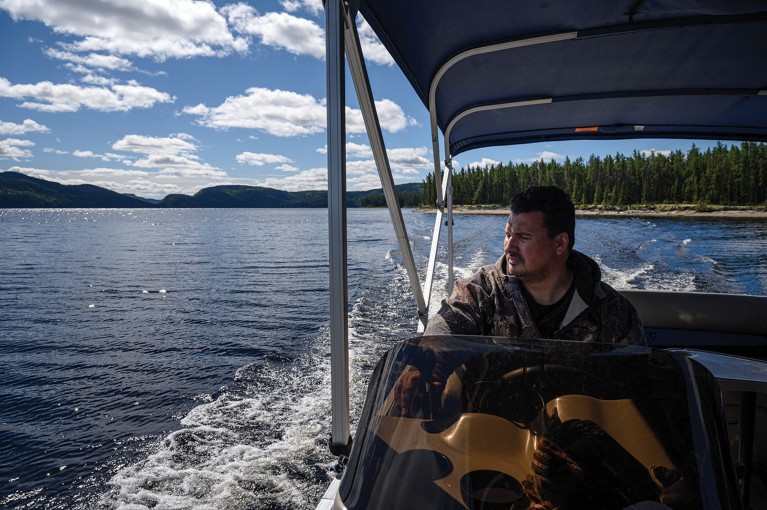Hello Nature readers, would you like to get this Briefing in your inbox free every day? Sign up here.

Oil wells dot the wheat fields in eastern Montana.Credit: William Campbell/Corbis via Getty
Sixteen young people in the United States are taking the state of Montana to court for environmental policies that they argue promote fossil fuels and are in violation of their right to a ‘clean and healthful environment’. It’s the first constitutional climate case in the country to make it to trial. Expert witnesses are likely to battle over the extent that specific climate events — such as extreme heat and wildfires — can be attributed to climate change. The judge in the case will not be able to order Montana to alter its energy or climate policies, but could declare the policies unconstitutional.
Nature | 6 min read
A survey of nearly 13,000 Icelanders has pinpointed, for the first time, mutations in a gene that correlate with a higher pitched voice, regardless of a person’s sex or age. The gene encodes a protein that ensures that collagen and elastin function properly. These proteins help tissues, including vocal chords, to stretch. People in the study with high-voice-pitch mutations were also more likely to have high pulse pressure, a risk factor for cardiovascular disease. The researchers suggest this is because collagen and elastin also play a part in the stiffness of blood vessels.
Nature | 5 min read
Reference: Science Advances paper
The leading theory of what’s going on inside atoms can’t properly describe the strong nuclear force. This fundamental interaction binds together protons and neutrons inside atoms. The results of an experiment that measured inflated atomic nuclei, contradicted the theory — so one of them must be wrong, says physicist Laura Elisa Marcucci. It’s still unclear whether the discrepancy could be resolved by including commonly ignored factors in the theoretical calculations or whether there’s a fatal flaw in our understanding of the strong force.
Quanta Magazine | 6 min read
Reference: Physical Review Letters paper
Features & opinion
Table of Contents
Long-term funding, patience and tailor-made solutions are crucial to tackling pervasive sexism in science, writes geophysicist Robin Bell. What works isn’t necessarily what people expect. “I was convinced that childcare during fieldwork was one of our biggest stumbling blocks for gender equity,” she recalls. “We found that making sure that women attended meetings and launched workshops — so the community could see them as intellectual leaders — was more important.”
Nature | 5 min read
In a freezer facility in Denmark cooled to –30℃, some 40,000 ice-core segments hold the key to Earth’s climate past and future. The cylindrical samples, drilled from ice sheets in polar regions, preserve climate history and reveal indicators of climate-driven impacts to come. Ice-core curator Jørgen Peder Steffensen has been presiding over these “volumes” of ice since the archive’s humble beginnings in a university basement in 1991. The icy library continues to surprise him. In 2019, Steffensen’s team discovered 30 glass jars with mud and rock collected in 1966 during the first time a drill reached the bottom of Greenland’s 1.4-kilometre-thick ice sheet. Analysis later uncovered ancient plant fossils that are between 1.4 and 3.2 million years old.
Hakai Magazine | 12 min read
The biggest light-producing organ in the world belongs to Taningia danae, the Dana octopus squid. Like most deep-sea squid, this species is adorned with bioluminescent photophores, and two of its arms are tipped with enormous ones — the size and shape of lemons, by far the largest known to science. The purpose of the organs is unknown, but tantalizing evidence — including a short video captured by a camera attached to an elephant seal — is shedding light on their function.
Nautilus | 8 min read
Where I work

Jean-Luc Kanapé is Guardian of the Pipmuakan forest in Quebec, Canada.Credit: Ed Jones/AFP via Getty
“I act as the eyes and ears of my people, the Innu,” says Jean-Luc Kanapé. As the Guardian of the Pipmuakan forest in Quebec, Canada, he combines ancestral knowledge with new technologies to track caribou, or reindeer (Rangifer tarandus). The animals are under threat from logging, which destroys their winter food source, lichen, and makes it harder for them to hide from predators such as wolves. “I want my grandchildren and the following generations to experience the richness of this forest,” Kanapé says. (Nature | 3 min read)
